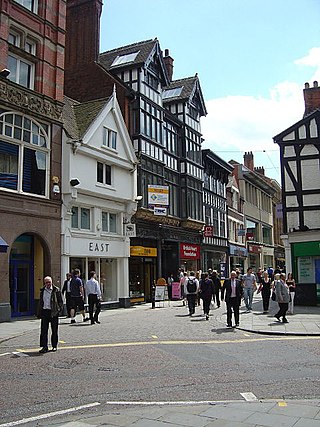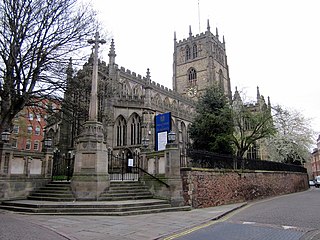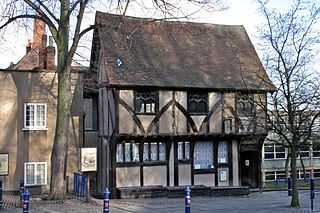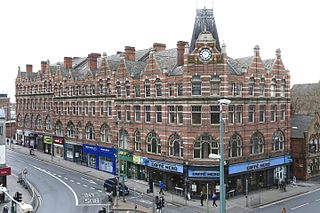 Wheeler Gate | |
| Maintained by | Nottingham City Council |
|---|---|
| Coordinates | 52°57′09″N1°09′00″W / 52.9525°N 1.1501°W |
Wheeler Gate is a street in Nottingham City Centre between Old Market Square and St Peter’s Square. [1]
 Wheeler Gate | |
| Maintained by | Nottingham City Council |
|---|---|
| Coordinates | 52°57′09″N1°09′00″W / 52.9525°N 1.1501°W |
Wheeler Gate is a street in Nottingham City Centre between Old Market Square and St Peter’s Square. [1]

In 1313 the street is referred to as Baxter Gate [2] but shortly afterwards became known as Wheeler Gate, or Wheel Wright Gate, as the location of the wheel makers.
It was 25 feet (7.6 m) wide at its narrowest point just below the Reindeer Inn, so the Town Council under took a project to widen it in 1885 to a uniform 60 feet (18 m) [3] with the buildings on the eastern side being completely replaced. The roadway was 40 feet (12 m) wide with pavements on each side of 10 feet (3.0 m) width.
In 1900, the conversion of the horse drawn tramway to electric power and extensions to the system built by the Nottingham Corporation Tramways included a double track route from St Peter’s Square along Wheeler Gate to join other tram lines in the Market Square. [4]


Salisbury Cathedral, formally the Cathedral Church of the Blessed Virgin Mary, is an Anglican cathedral in the city of Salisbury, England. The cathedral is considered the beau idéal of Early English Gothic design. Built over a relatively short period, some 38 years between 1220 and 1258, it has a unity and coherence that is unusual in medieval English cathedrals. The tower and spire were completed by 1330 and at 404 feet (123 m) is the tallest church spire in England.

Bedford Square is a garden square in the Bloomsbury district of the Borough of Camden in London, England.

Nottingham Council House is the city hall of Nottingham, England. The 200 feet (61 m) high dome that rises above the city is the centrepiece of the skyline and presides over the Old Market Square which is also referred to as the "City Centre". It is a Grade II* listed building.

Bridlesmith Gate is a pedestrianised shopping street in the city centre of Nottingham, England. It is located between Middle Pavement and Victoria Street. St. Peter's Gate and Bottle Lane stem off it along with Byard Lane.

Welbeck Abbey is an English mansion situated in the village of Welbeck, which is within the civil parish of Norton, Cuckney, Holbeck and Welbeck, in the Bassetlaw District of Nottinghamshire. It was the site of a monastery belonging to the Premonstratensian order in England and after the Dissolution of the Monasteries, a country house residence of the Dukes of Portland. It is part of the Dukeries, four contiguous ducal estates in North Nottinghamshire. The house is a Grade I listed building.
Thomas Cecil Howitt, OBE was a British provincial architect of the 20th Century. Howitt is chiefly remembered for designing prominent public buildings, such as the Council House and Processional Way in Nottingham, Baskerville House in Birmingham, Newport Civic Centre, and several Odeon cinemas. Howitt's chief architectural legacies are in his home city of Nottingham. He was Housing Architect for the City Council, designing municipal housing estates which are often considered to be among the finest in terms of planning in the country.

Daybrook is a suburb of Arnold, Nottinghamshire. The area is located just outside the city of Nottingham but inside the conurbation of Greater Nottingham. It lies next to the areas of Arnold town centre, Sherwood, Woodthorpe, Redhill and Bestwood.

As of February 2001, there were 1,124 listed buildings with Grade II status in the English city of Brighton and Hove. The total at 2009 was similar. The city, on the English Channel coast approximately 52 miles (84 km) south of London, was formed as a unitary authority in 1997 by the merger of the neighbouring towns of Brighton and Hove. Queen Elizabeth II granted city status in 2000.

The County War Memorial, Nottingham is a Grade II listed structure in Nottingham in Nottinghamshire, England.

Samuel Dutton Walker F.S.A. was an architect based in Nottingham.

John Howitt FRIBA was an architect based in Nottingham.

Severn's Building is a Grade II listed building dating from the 15th century in the English city of Nottingham. Originally located in the city's Middle Pavement, it was relocated to the junction of Castle Road and Castle Gate around 1970.

Robert Evans FRIBA, JP was an English architect based in Nottingham.

William Jolley was an English architect based in Nottingham.

Castle Gate is an historic street near the centre of the English city of Nottingham. The street runs uphill, from a junction with Low Pavement, Lister Gate and Albert Street in the city centre, to Castle Road, near to the entrance to Nottingham Castle. The street is noted for its Georgian houses, many of which are listed buildings. There is also a complex of rock-cut caves, under buildings at the lower end of the street, which is a scheduled monument.

Carrington Street is a street in Nottingham city centre between Nottingham station and Broadmarsh.

South Parade is a row of buildings in Nottingham City Centre forming the south side of Old Market Square, Nottingham which runs from Wheeler Gate to Exchange Walk.

Hounds Gate is an historic street in the centre of the city of Nottingham between St Peter’s Square and Castle Road.

Whitefriargate is a pedestrianised street in the Old Town area of Kingston upon Hull, in the East Riding of Yorkshire, England. During the 20th century, it was one of the main shopping streets in the city centre, but some of the major stores have closed down, which has been attributed to out of town shopping centres. However, the Street still provides a useful link to and from the old town of Hull.

Willoughby House is a Grade II* listed building on Low Pavement in Nottingham.